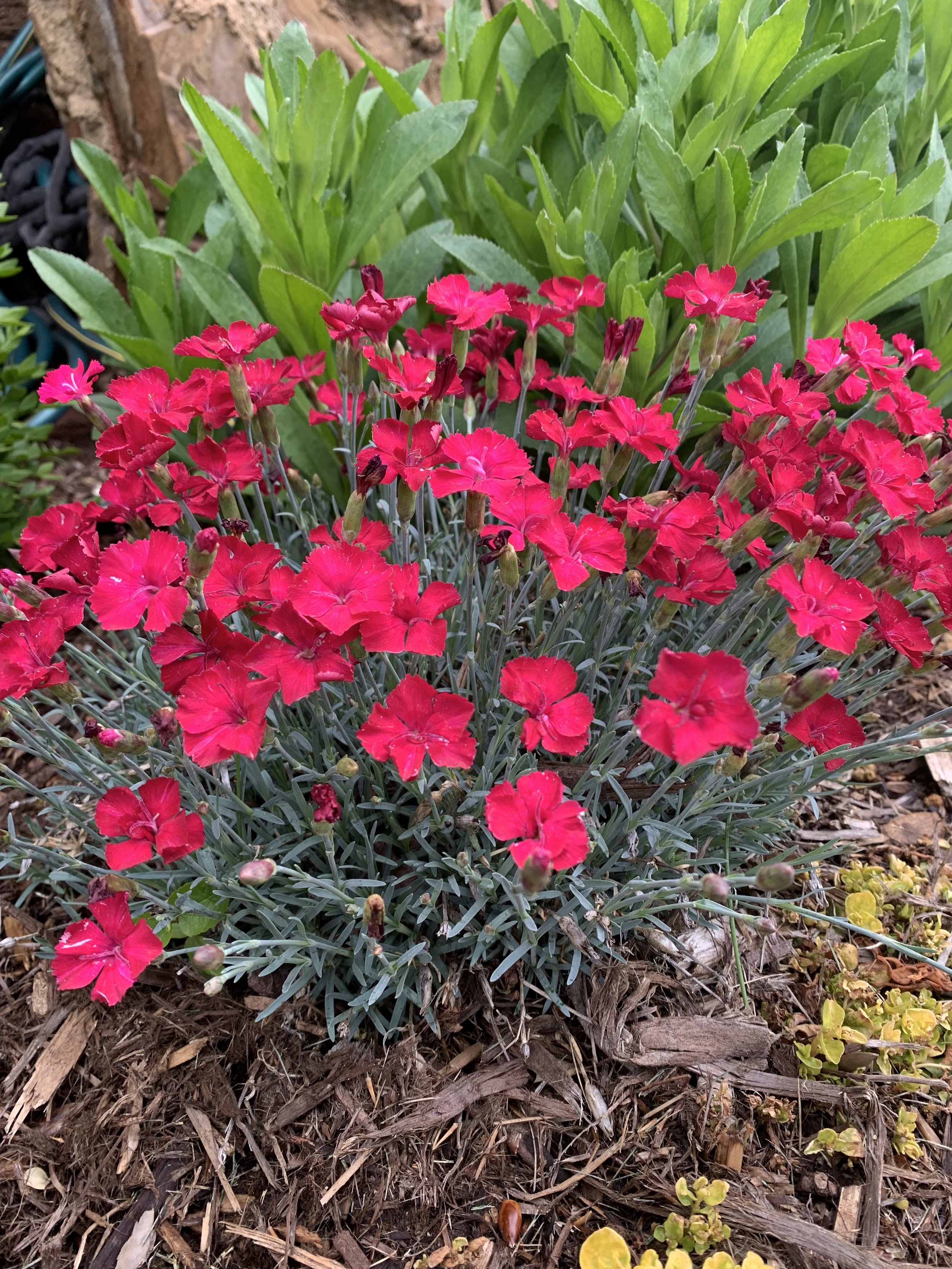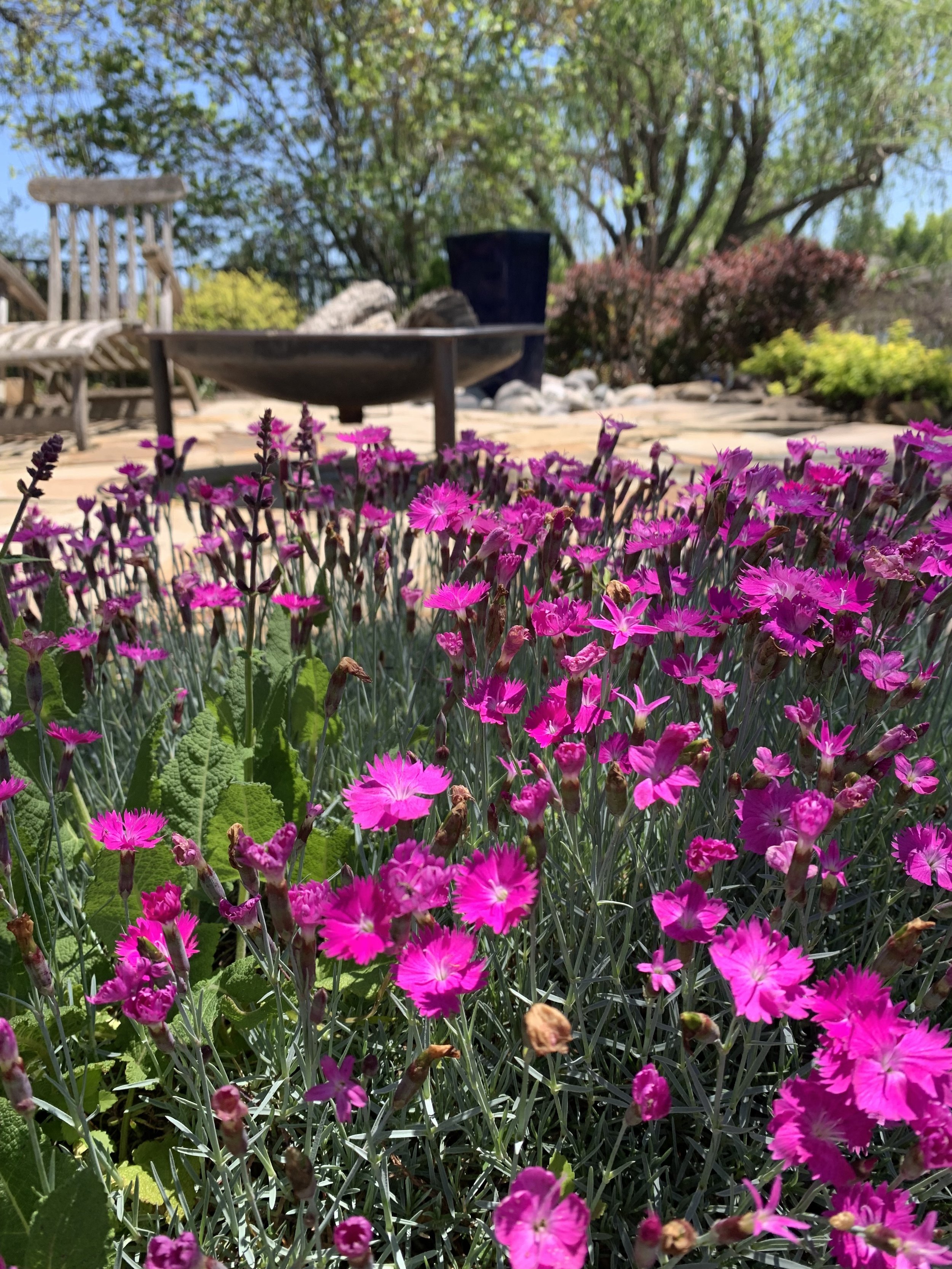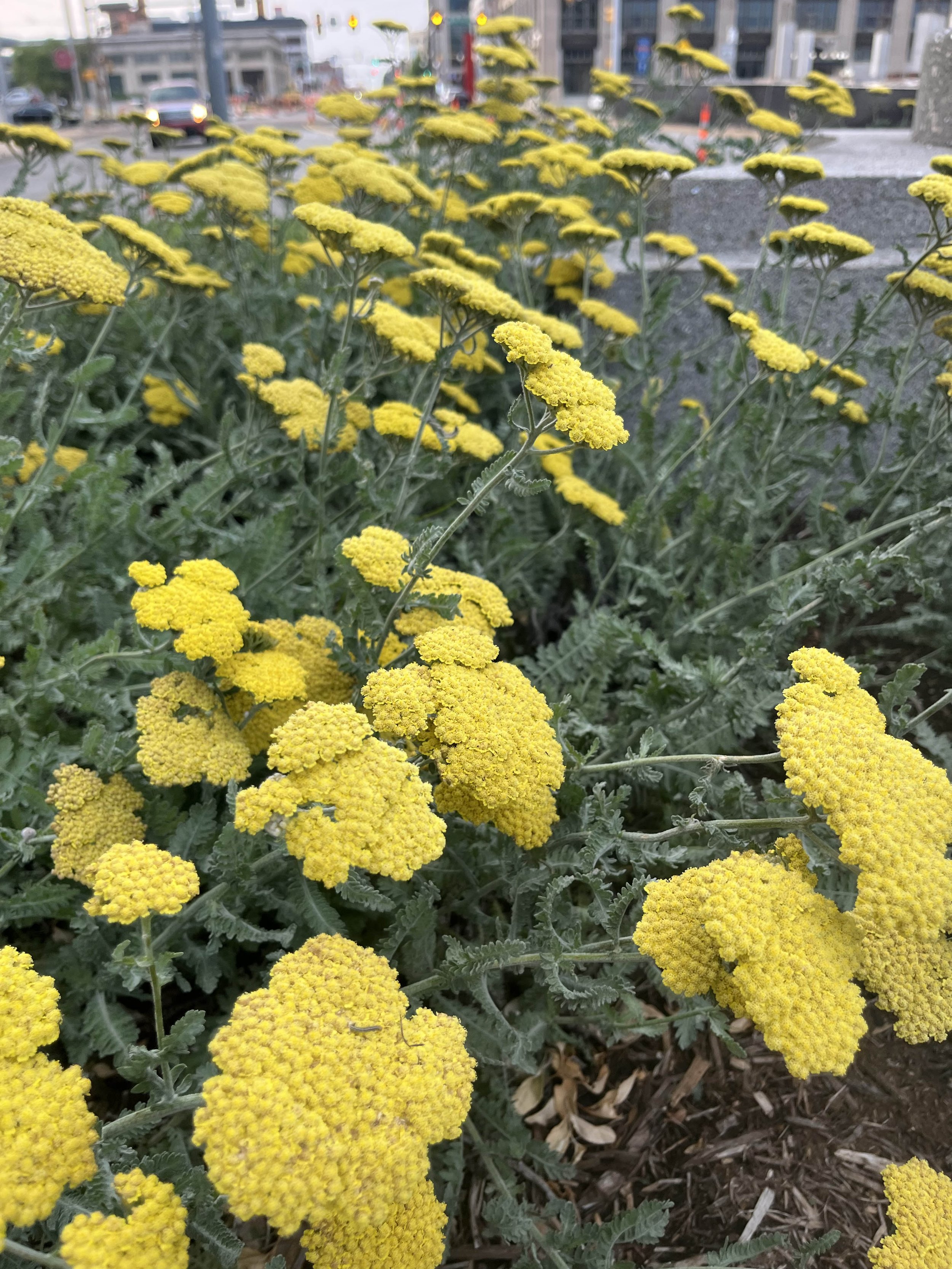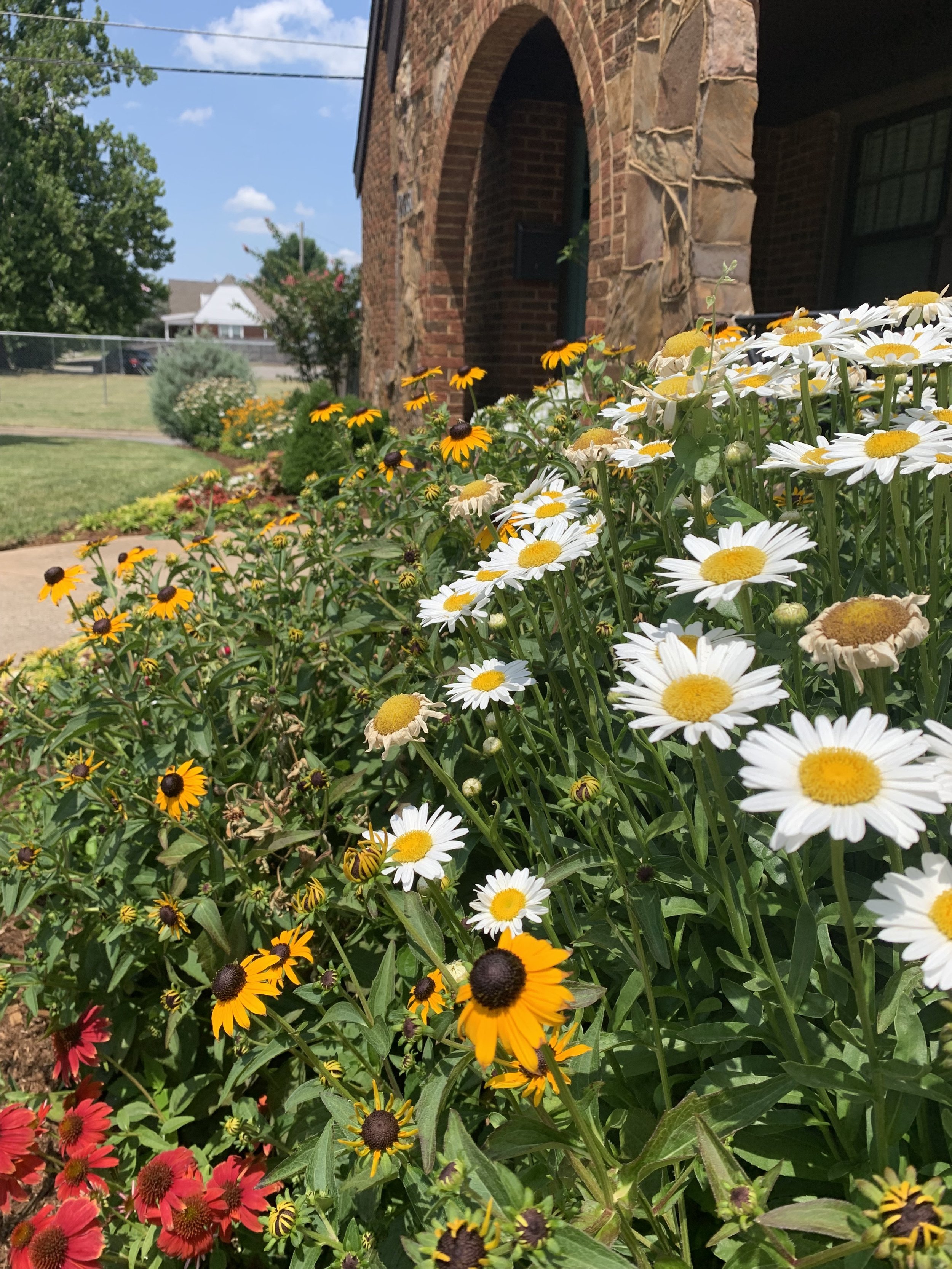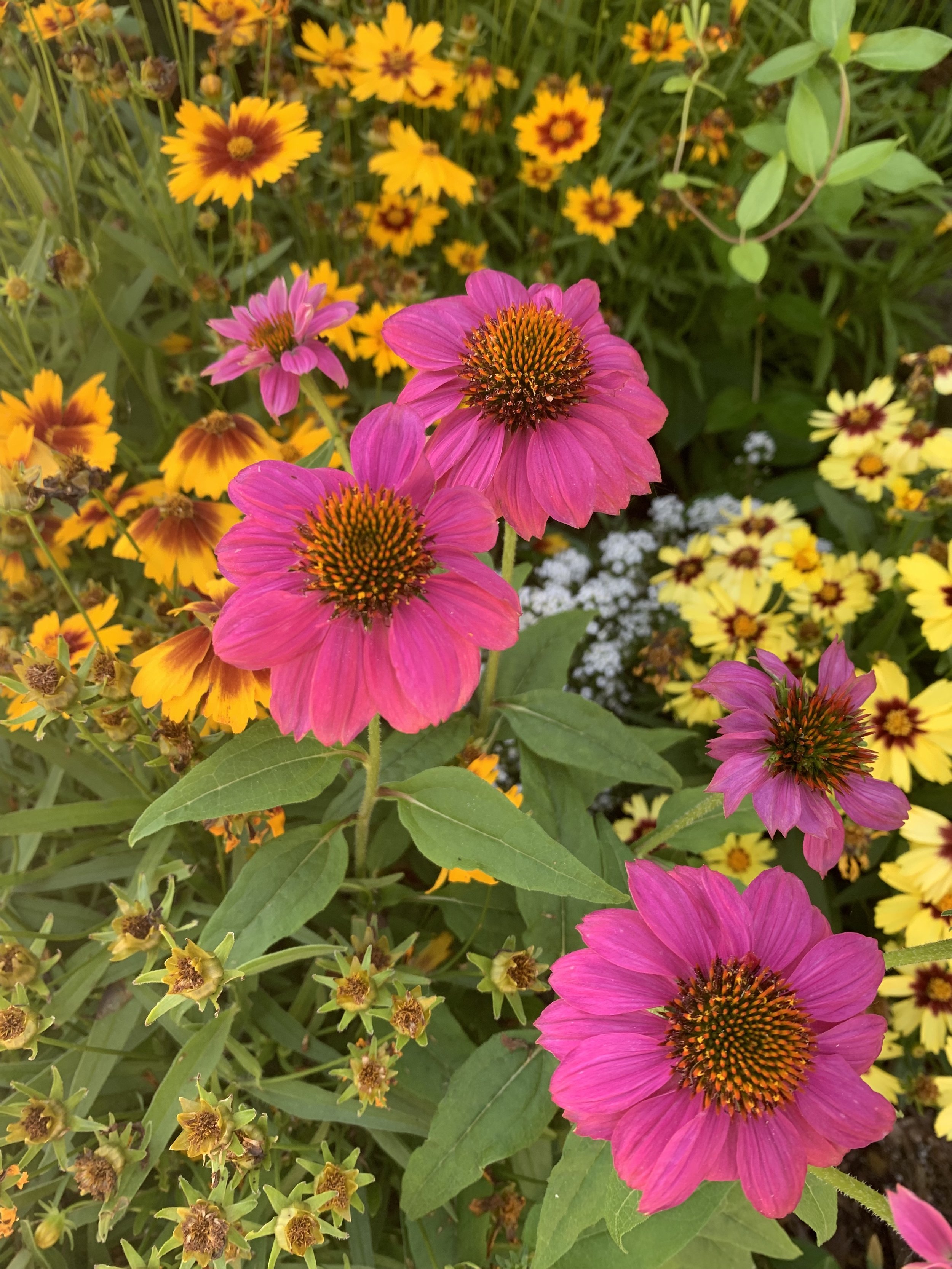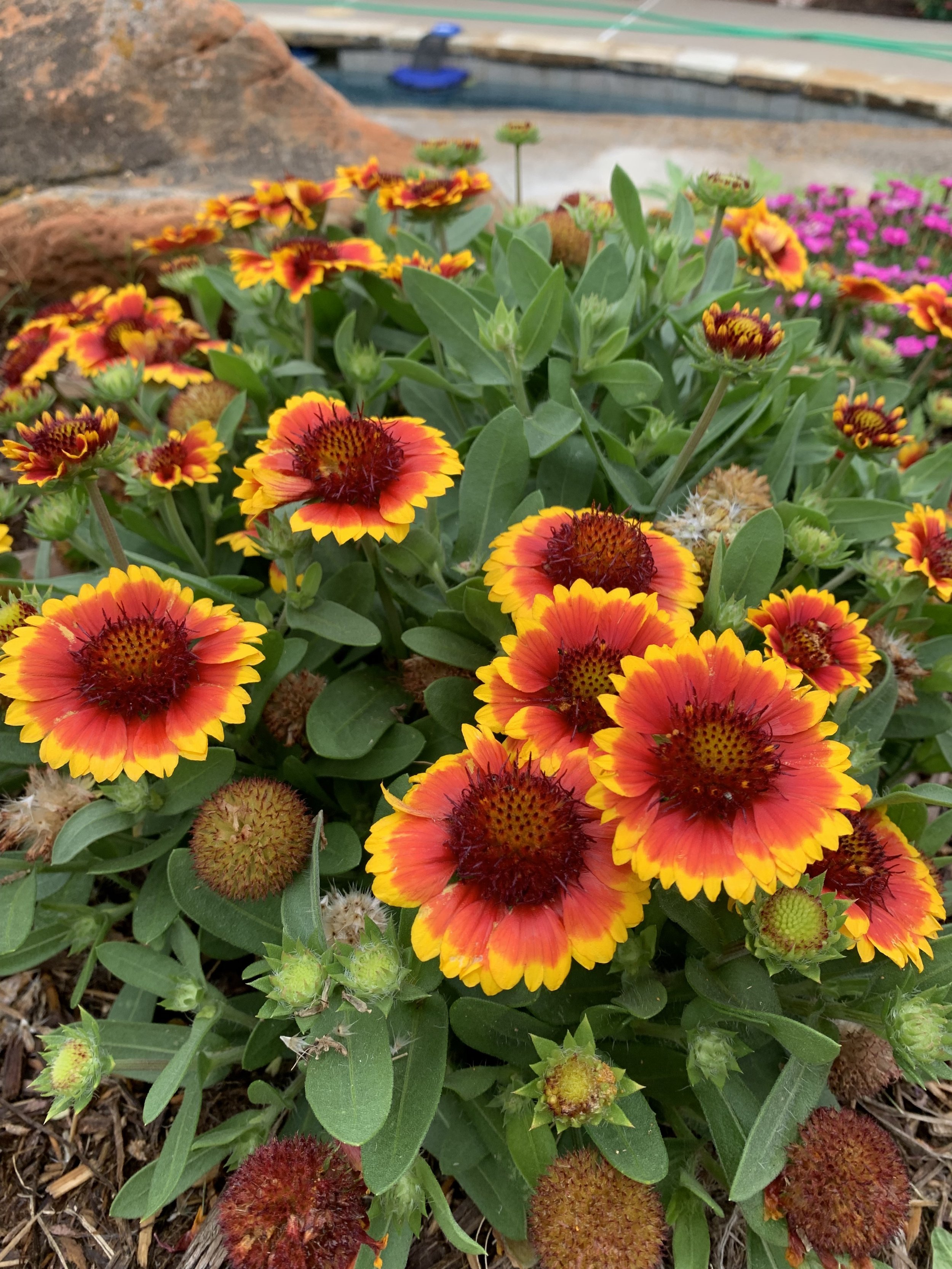More perennials, please!
Over the years, I have become more and more fond of using perennials in the landscape.
In the early days of my love for landscapes, I was slow to add perennials because they don’t add color all season and often their foliage is unattractive after the blooms faded. When I did add a few, they always found their home in an out of the way, background location of the landscape.
I still believe annual color is the best choice close to the front door, along the front walks, and key areas around outdoor living spaces. Annual color is the best way to create a bright, welcome and season long statement in the landscape. But, more and more, I find myself adding perennials to landscapes.
What is the difference between annuals and perennials?
Perennial plants regrow every spring.
Annual plants live for only one growing season and then die.
Perennials usually have a shorter blooming period compared to annuals.
Great landscapes use a combination of both plants.
There are so many perennial choices. Every year, growers introduce new varieties of the old tried and true perennials. Every year, I enjoy trying a perennial I haven’t used in a landscape before.
I have my favorites. Favorites that have found a home in my landscape, and although none of them add color the entire season, it is fun to discover something new blooming in the landscape as we pass through the seasons.
Creeping Phlox (Phlox stolonifera).
The first to welcome spring each year. Creeping phlox produces a spring-like carpet in pastel hues of white, lavender, red and pink. Creeping phlox is a moderate grower that can spread up to 2’ but only reaches 4-6” in height. It prefers full sun but will tolerate some shade each day. Borders, walls, and around boulders are where it looks best. In my garden, you will find it cascading over a rock retaining wall. It tolerates most soils as long as it is well drained. The plant requires little maintenance. Mites are about the only insect problem it will have.
Creeping Phlox
Creeping phlox cascading over any landscape wall is a great way to say “hello” to spring.
Dianthus
Dianthus and Salvia planted along a flagstone walkway.
A must have perennial for cut flowers is Peony. With sturdy stems and spectacular blooms they not make April to early May pretty outside, but inside too.
Creeping Phlox
Creeping Phlox
Dianthus (Dianthus).
It works well as a border, in small groupings, around boulders or as a single plant reaching 10-15” tall with a spread of 12-24”. They bloom in late spring to early summer in rose, pink, white, red. They prefer areas where they will receive at least 6 hours of full sun each day but will tolerate some dappled shade or afternoon shade. Just like creeping phlox, they are a cool season lover. They will grow in most soils, prefer alkaline soils, but waterlogged soil will cause crown and root rot. Heavy mulching near the crown of the plant can be detrimental. Late March through April and into May is the peak bloom time. Light feeding in the spring with a complete fertilizer of phosphorus, potassium and low nitrogen is recommended. Other than an occasional aphid or powdery mildew issue, they do not have many problems. There are more than 300 varieties of dianthus to choose from. My all-time favorite is ‘Firewitch’. It has silver-green foliage and a vibrant pink bloom. One short coming – it is not uncommon for them to thrive for a few years and then gradually decline, so you may need to replant every 3-4 years. I have found this true with the dianthus planted in my front landscape, but at the same time, I have a planting of dianthus in my back landscape that has over performed for at least 10 years running.
Dianthus
Peony (disambiguation) –
Easily one of the most old fashioned, coveted perennials. With sturdy stems and spectacular blooms, a peony is a mut have in your landscape just for cut flowers in late April to early May. Peonies are a large, 2-3’ tall, bushy shape with deeply lobed leaves that make a great back drop for a border of groundcover, smaller plants or spring bulbs.
‘May Night’ Salvia (Salvia x sylvestris).
Sage type flower spikes of deep bluish-purple that will add color in April, May and early June. The best flower show will be in full sun, but it will tolerate a little dappled shade each day. The plant grows 12-18” tall with flower spikes reaching 24”. The plant looks great in the middle of the garden planted behind creeping phlox or dianthus, and in front of Shasta daisy or Black-eyed Susan. The leaves often become tattered later in the summer. Keep faded blooms removed to maximize bloom period and pruning the plants after blooming may result in a few fall blooms. In the early spring, before new growth emerges, remove the dormant foliage. Salvia tolerates clay soils but will struggle with root rot if the soil stays saturated.
With nearly 1,000 species new varieties and colors of salvia arrive every year. For the latest information on salvia introductions, visit Proven Winners https://www.provenwinners.com/learn/how-plant/salvia
Cutting Salvia back after it has finished blooming for the season.
From April through early June you can count on May Night Salvia adding deep blue to purple spikes of color to the landscape.
Pink Dianthus, May Night Salvia with Gold Moneywort ground cover.
Yarrow
Daylily
Daylily (Hemerocallis).
There are over 80,000 varieties of daylily. They come in nearly every color and shade of color you can imagine, ranging 10-36” tall and 12-24” wide. Depending on the variety, blooms start in early summer and extend into late summer with a successive blooming habit that lasts 4-6 weeks. They also are one of the most adaptable plants. They are very cold hardy and very heat tolerant. They are happy in almost every soil condition, clay, loam, dry, wet, low nutrient. They prefer full sun but will bloom in partial shade. With a clump type growth, they are dynamic planted in a mass grouping. Leave dormant foliage until new foliage emerges in the spring. Fertilize in early spring and again in early summer. Clumps can be divided every 3-5 years in the fall. Remove spent flower stocks to encourage more blooms. The most common yellow daylily is ‘Stella de’ Oro’. ‘Pardon Me’ is a great red daylily. Planting daylilies behind liriope (monkey grass) will help cover up the unattractive foliage as it begins to fade in late summer. Look around, daylilies started putting on their early summer show this week.
‘May Night’ Salvia
Dianthus and Salvia make a great combination to your May landscape.
May Night Salvia
Yarrow (Achillea millefolium).
I’m sure you have noticed yellow yarrow in landscapes for years, but more recently you are seeing red, white, pink and purple tones of yarrow in the landscapes. An early bloomer with ferny foliage that make a great addition in full sun landscapes. Plant in groups in the front or middle layer of the landscape bed. They are also great in a butterfly garden.
Yarrow
‘Cat’s Pajamas’ Catmint is a long blooming small mounding perennial that is covered with blue flowers from late spring through summer.
Daylily
Red Coneflower, Black-eyed Susan and Shasta Daisy
Banana Cream II is an improved variety of Daisy with lemony yellow flowers.
Shasta Daisy (Chrysanthemum x superbum).
Classic daisy appearance of white petals around a yellow center. They grow in clumps 1-2’ wide and 2-3’ tall. Best if planted in fertile soil that drains well. The more sun they receive the more they will bloom. Shasta Daisies start blooming in early summer and can last until early fall. They make great cut flowers. Keeping the faded blooms cut will extend the color show. After the foliage goes dormant in late fall, cut the stems back to 1-2”. They respond well to light fertilizer in the spring. Daisies perform best if they are divided every 3-5 years. Considered as a low maintenance plant, aphids are about the only insect you may see. ‘Becky’ is a favorite variety.
A newer addition to the Shata family is Banana Cream II. Proven Winners is a great place to learn more about adding daisies to your landscape. https://www.provenwinners.com/learn/how-plant/shasta-daisy
Black-Eyed Susan (Rudbeckia grandiflora).
Daisy like golden-yellow flower petals surround a dark brown or black center reaching 2-4’ and spreading 2’. The large flower blooms (2-4”) will be arriving in the next few weeks and will continue into July. And, if you keep spent blooms trimmed off, you will get a few blooms in the fall. Plant in sun to partial shade. As a native prairie plant, you will find it to be low maintenance. It tolerates most soils but prefers well drained. Because of its height, plant in the middle of a bed or as a background to lower perennials, such as dianthus or salvia. The plant can be divided every 3-5 years. Remove dormant foliage anytime in the fall or winter. It can develop powdery mildew if in too much shade. Minimal feeding is required. Keep a watch out for occasional aphid problems.
One of the best late summer blooming perennials is Black-eyed Susan.
Black-eyed Susan
Black-eyed Susan
Because of its height, plant in the middle of a bed or as a background to lower perennials, such as dianthus or salvia. The plant can be divided every 3-5 years. Remove dormant foliage anytime in the fall or winter. It can develop powdery mildew if in too much shade. Minimal feeding is required. Keep a watch out for occasional aphid problem.
Coneflower
One of the longer blooming summer perennials is Coneflower.
Coneflower
Coneflower (Echinacea).
A native prairie plant with purple or white blooms 2-4” in diameter. Just like black-eyed susan it reaches 2-4’ in height and spreads out 2-3’ and makes a good show planted in the back or sides of the garden. But, it also works well as a single specimen. Plant in sun to partial shade. It is one of the longest summer bloomers with a show that lasts 5-8 weeks. The coarse texture of the leaves makes them well suited near softer-textured plants such as ornamental grasses. It enjoys well-drained, fertile soil. Removing faded flowers will encourage more blooms. Remove dead foliage in the winter. Coneflowers are fairly disease tolerant and responds to feeding early in the growing season and also likes to be mulched.
Hardy Verbena (Verbena).
This low growing (4-6”) spreading (2-3’) perennial thrives in summer heat while producing purple, pink, red or white blooms. Verbena is not picky about soil type but requires full sun. When it gets more than 2-3 hours of shade per day, its biggest problem is powdery mildew disease increases. The low growing nature makes it perfect for the front of beds, along walks and cascading over walls and slopes. It also looks great in pots and window boxes. Good drainage and fertile soils needed and with consistent irrigation blooms and spread will increase. Feed in spring and after the first flush of heavy blooms. Don’t fertilize after July. Verbena likes mulch to insulate roots and hold in moisture. Shearing the plant just below spent blooms will encourage growth and more flowering. My favorite variety is ‘Homestead Purple’.
We think of Garden Mums as fall color, but they also bloom in late spring to early summer. After the early blooms fade shear them back to the shape and height you prefer and then don’t prune on them again after the 4th of July.
Garden Mum (Chrysanthemum x moratorium).
Typically thought of as an annual, but they make a great perennial for fall color with shades of pink, red, white and yellow. Plant height and width are both 1-3’ resulting typically in a round shape. They produce a wonderful burst of color for 2-4 weeks in late September and October. Mums will tolerate light shade but prefer full sun. To survive the winter as a perennial, they need moisture and good drainage. Therefore, add an ample amount of compost when planting in our clay soils. Dormant foliage can be removed anytime during the winter or in the spring when new growth emerges. Mums will bloom a little in the spring or early summer. Once the early blooms fade, keep the plant sheared to the shape and height you prefer. Stop shearing after the first of July. When you shear a mum during the last half of the summer, you are removing the flower buds for the fall.
Hosta (Hosta).
Monrovia.com lists over 78 varieties of hosta. This shade to partial sun loving plant is perfect for adding brightness to shady areas. Varieties range in size, but 12-14” tall and 30” wide is common. They prefer organic soil and regular watering when it is hot. Their leafy appearance is a great companion to ground covers. Monrovia calls them “the potato chip of plants…once you have one and watch how it lights up the shade you will want another.” One of my favorites is ‘Patriot’. I dare you to plant just one.
A favorite, Patriot Hosta, is a compact variety with glossy dark green leaves with white edges. It is also more heat tolerant than most varieties.
King Ostrich Fern
Fern.
Excellent for shade gardens and damp areas. They require frequent watering, especially in the summer heat. There are many varieties but for most gardens, ones that grow 18-30” with a 24” spread, are best. They are an easy-going plant that adds texture to the landscape. It is a great plant for filling in bare areas in the shade. Matteuccia struthiopteris ‘The King’ is a favorite Ostrich fern.
Coral Bells (Heuchera).
A great shade companion to hosta and caladium, but this perennial will also be happy planted in a little more sun. It makes a great border, a mass grouping, or plant a single plant as an accent. There are many varieties with colorful foliage to choose from. ‘Palace Purple’ has deep purple foliage which looks great planted with ‘Patriot’ Hosta.
Coral Bells
Coral Bell 'Palace Purple' planted as an accent with fern in a shady raised planter.
Gaillardia
The best time to add perennials to your landscape is spring and fall. But, you can find success adding perennials most anytime; just avoid the hottest days of the summer and the coldest period of the winter. My favorite time to add perennials is when I am planting my annual color in the spring or fall.
A great resource is Monrovia.com. https://www.monrovia.com/plant-catalog/
Another great way to learn more about perennials is to take monthly walks through the Myriad Garden and Scissortail Park to see what is currently in bloom.
What are your favorite perennials?
We are always on the lookout for new ideas.
Text or email us a few pictures of perennials blooming in your landscape!
Lorne Hall
Hall | Stewart Lawn + Landscape
(405)367-3873






